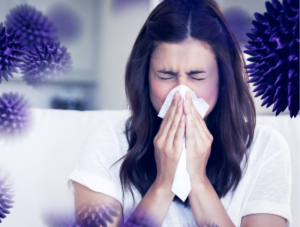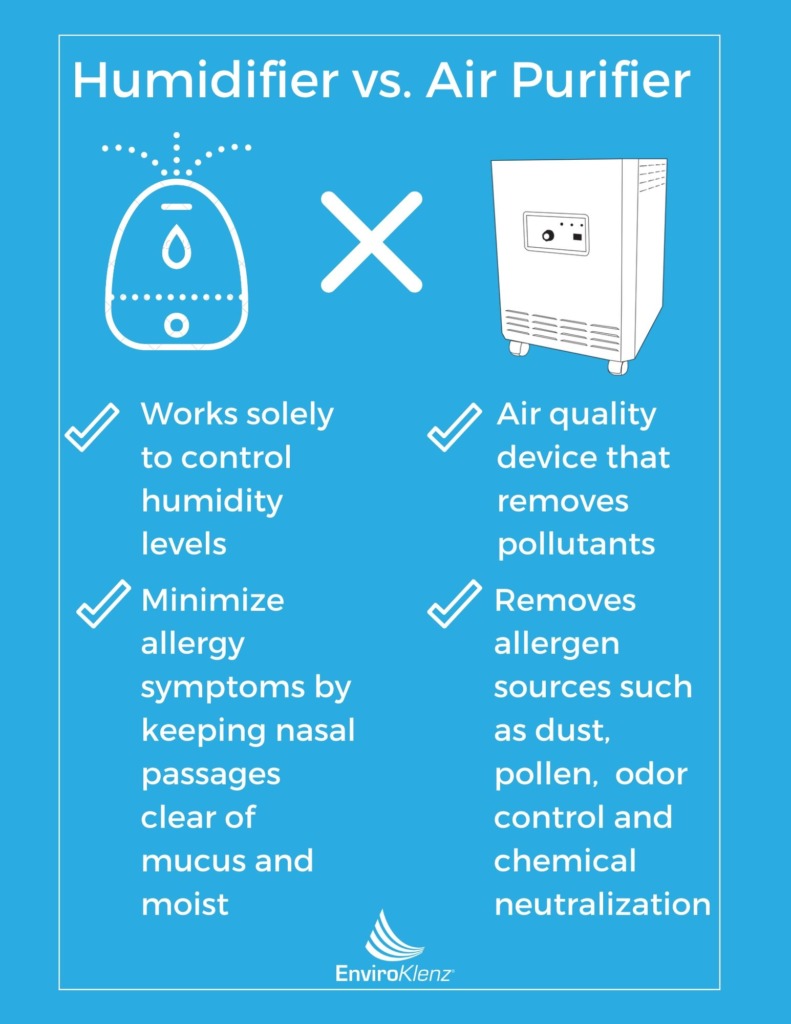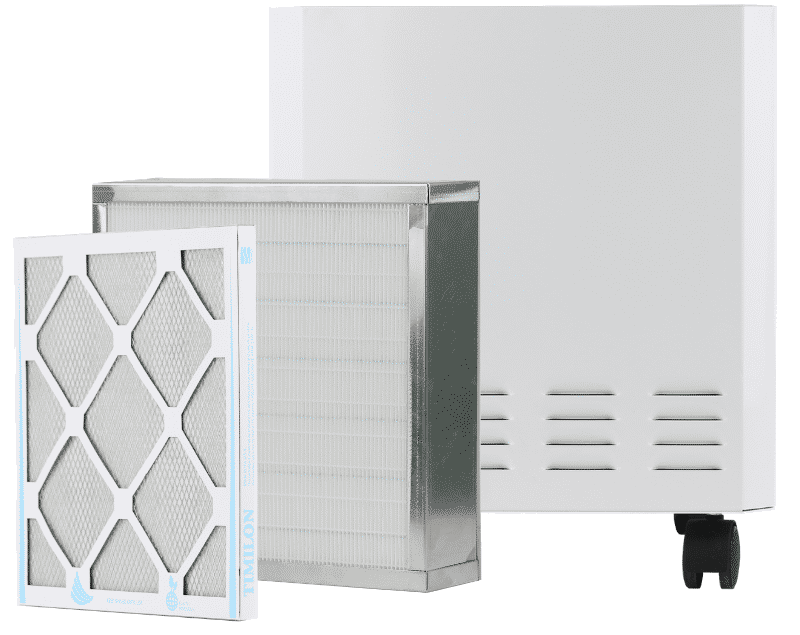A spike in your allergies has suddenly occurred and particularly inside the indoor space of your home. The frequent bouts of sneezing, coughing, eye irritation, and even fatigue that comes in waves as you inhabit the indoor environment of this personal space. If you have noticed that the onset of allergies only takes place in your home than you may need to put your detective hat on and start assessing the surfaces and air inside your home. Allergens can invade an environment quickly and often times unknowingly – as it will appear on various surfaces such as flooring, counters, cabinets, etc. These are the areas in a home that we will pay the most attention to and rigorously clean and remove the allergens from, however, allergens can also infiltrate the indoor air of this environment, which can cause the large portion of allergy symptoms for occupants that suffer from allergies.
When it comes to removing airborne allergens from the air space of a home, there can be several air quality devices that can be used to try to mitigate these airborne pollutants. Among these air quality devices, most people will turn to both/either an air purifier or a humidifier. However, when it comes to cleaning the air of indoor allergens, in particular, does a humidifier help with allergies or is an air purifier the superior option?
In this article we are going to learn more about the benefits of using a humidifier in your home for allergies, how a humidifier will work in the air space, and discuss the major differences between an air purifier vs a humidifier for airborne allergen removal in the air of your personal indoor environment.
What is a Humidifier
Have you ever used a humidifier before inside your home to help with the conditions of the air in this environment? If not, then you may not understand what exactly a humidifier is and what it can do for the air inside your home. Generally speaking, a humidifier will work to add moisture to the air that will help to prevent dryness that can cause irritation in many parts of the human body. This addition of moisture in the air will definitely help will treating dryness of the skin, nose, throat, and lips. When an indoor environment contains lower levels of humidity in the air it can cause adverse health effects to certain individuals exposed to this environment, such as a drying out of the mucous membranes and respiratory distress.
These air devices that emit water vapor or steam into the air to increase moisture levels in the air can come in several various types that can be used in an indoor space like a home. According to Mayo Clinic, some of the most popular types of humidifiers include central humidifiers, ultrasonic humidifiers, impeller humidifiers, evaporators, and steam vaporizers. Ultimately, when it comes to using a humidifier you want to make sure that you are within the optimal levels of humidity inside your home, which is between 30% and 50% humidity in the air.

How Does a Humidifier Work
The functioning of a humidifier will depend on the specific type of humidifier that is used, as they each will work in different ways to add moisture into an indoor personal environment. According to How Stuff Works, the most common type of humidifier that is used inside of indoor environments is an evaporative humidifier. An evaporative humidifier will work very simply in the environment and will act as a self-regulating air device. This humidifier contains a reservoir that holds cold water and dispenses it into a basin, in addition a wicking filter absorbs the water from the basin and then the fan in the humidifier will than blow air through the moistened filter. When the air passes through the filter in the humidifier, it will evaporate some of the water that is released into the air space.
These humidifiers can sometimes be hooked up to the heating and cooling system of a house or building. These systems work in a similar way; the mesh or screen is located in the duct coming from the furnace and/or air conditioner. However, the humidifier works, it will also produce the same results adding moisture into the air to regulate the humidity in the indoor space that can be adversely impacting the health of the occupants.
When To Use A Humidifier
When it comes to using a humidifier, there are several ways to use them in both a home and/or an office, however, there can also be some risks from using these air devices. Whether it be for preventing viruses like the flu, reducing coughing, reducing snoring, keeping hair and skin moist, or even other benefits around the home – whatever the case may be a humidifier can present significant benefits to the air space. The most significant benefits are what humidifiers can do for the health of those individuals in the indoor air space.
One study has found that humidifiers can also help to avoid getting the flu when used inside of your home. A study conducted by the National Academy of Sciences found that a strong relationship between dry conditions and the transmission and survival of the influenza virus. They found that when the amount of absolute humidity in the air was too low, the flu virus was able to survive longer and spread easier amongst those in the environment. Additionally, a humidifier can help to ease symptoms associated with many illnesses and this can include breathing difficulties, stuffy nose, dry throat, etc.

Is a Humidifier Good for Allergies?
Did you know that breathing in air with higher humidity is one way to relieve the discomfort and symptoms of allergies? Allergic rhinitis, also known as allergies, is an allergic response that an individual may experience to a specific allergen in the environment, and these allergens can include pollen, dust, pet dander, mold, etc. Nearly 8 percent of adults in the United States will experience allergic rhinitis of some kind, according to the AAAAI. Therefore, these individuals that are constantly at battle with their allergies, especially in their home may be looking for methods and solutions to mitigating and controlling the symptoms they experience from these allergens in the indoor environment. Whether you are have an allergy to mold, dust mites, or other allergens a humidifier may not be the best option.
When you have a well-balanced level of humidity in a home’s air it can work to help keep your nasal passages clear of mucous and this can help with respiratory problems that an individual may be experiencing. In general, this added humidity will help to mitigate allergy symptoms, however, according to the American Academy of Allergy, Asthma & Immunology (AAAAI) if you have indoor allergies, dust and mold from the humidifier may cause more harm than good. For example, dust mites are a common type of allergen found in homes, and when the air is moisturized from a humidifier, it will create the ideal conditions for dust mites to live and prosper – this can lead to a flare in allergies in those allergic to these allergens.
Humidifiers or Air Purifiers for Allergies
 There is a lot of confusion surrounding the differences between the two popular air devices used in home; air purifiers and humidifiers. An air purifier is an air quality device that is designed to be placed inside of an indoor environment to clear the air of airborne pollutants such as allergens dust, odor control, and even chemical neutralization. Whereas a humidifier works solely to control the humidity levels within a given indoor environment – as they do nothing to control the air quality and the number of pollutants present in the air space.
There is a lot of confusion surrounding the differences between the two popular air devices used in home; air purifiers and humidifiers. An air purifier is an air quality device that is designed to be placed inside of an indoor environment to clear the air of airborne pollutants such as allergens dust, odor control, and even chemical neutralization. Whereas a humidifier works solely to control the humidity levels within a given indoor environment – as they do nothing to control the air quality and the number of pollutants present in the air space.
Obviously, when it comes to allergens that are present in the air space of your home or other indoor spaces, then an air purifier will be the optimal solution to many of these allergy problems. However, a humidifier can also help when it comes to keeping the nasal passages moist, which will help to minimize the frequency and severity of the symptoms that are triggered by allergies. Therefore, it will depend on the indoor space, the conditions that an occupant is experiencing, and the ultimate goal that you are trying to achieve (whether that be removing the allergen sources or minimizing onset allergy symptoms).
Can You Run an Air Purifier and Humidifier at the Same Time?
If you suffer from allergies, it is possible to use both a humidifier and an air purifier in the same indoor air space, as they will both work to accomplish different things within your indoor air. These two air devices work completely different in the air, and therefore they should be placed within a certain distance of one another. The humidifier will be used to add moisture to the air, allowing for the humidity to stay between the optimal percentage such as 30 and 50 percent – this humidity will help to alleviate various symptoms that are provoked from an allergic response to allergens in the air. Whereas an air purifier will work specifically to filter the indoor air of airborne pollutant such as allergens through the use of certain filtration methods used within this device, such as a HEPA filter.
When it comes to an air purifier there are various technologies that can be used such as carbon, ozone, ionization, and even HEPA filtration. Each of these air filtration technologies will work in specific ways to filter the air of contaminants, and some of these will only remove certain pollutants from the air such as allergens, chemicals, and odors. However, when it comes to air purifiers what is the best technology to use to remove allergens from your indoor air?
HEPA Air Purifier for Allergies
 How to get rid of allergies may be easier than you think. Air purifiers that work for allergies and allergen removal in the indoor air space of a home will contain filters that are capable of removing fine particulate matter from the air such as airborne allergens. Among these different air purifier filters that works for the capturing and containing of these fine particulate matters will include the popular and most effective HEPA filter air purifier for allergies. HEPA filters are made of a very fine glass thread that has a diameter less than 1 micron in size. The fine glass threads of the HEPA are tangled together and compressed to form a filter mat media. The individual threads are so tiny and microscopic that a big portion of the media mat consists of air. The openings inside the mat are small, generally smaller than 0.5 microns, allowing the HEPA to collect particles down to 0.3 microns in size, such as allergens that are present in most indoor air spaces.
How to get rid of allergies may be easier than you think. Air purifiers that work for allergies and allergen removal in the indoor air space of a home will contain filters that are capable of removing fine particulate matter from the air such as airborne allergens. Among these different air purifier filters that works for the capturing and containing of these fine particulate matters will include the popular and most effective HEPA filter air purifier for allergies. HEPA filters are made of a very fine glass thread that has a diameter less than 1 micron in size. The fine glass threads of the HEPA are tangled together and compressed to form a filter mat media. The individual threads are so tiny and microscopic that a big portion of the media mat consists of air. The openings inside the mat are small, generally smaller than 0.5 microns, allowing the HEPA to collect particles down to 0.3 microns in size, such as allergens that are present in most indoor air spaces.
 The EnviroKlenz Air Purifier is your solution for indoor allergen removal inside of your home, as this two-stage air purification system uses both a patented technology for odor and chemical neutralization, as well as a hospital-grade HEPA filter for fine particulate removal like allergens from the air. The EnviroKlenz patented technology contains safe, nontoxic earth minerals that are embedded within an air cartridge that acts as the first stage of filtration – that capture, contain, and neutralize a broad spectrum of noxious and toxic chemicals and odors that are airborne. Whereas the second stage of filtration in the EnviroKlenz Air Purifier is a hospital-grade HEPA filter for fine particulate removal larger than 0.3 microns in size at a 99.99 percent efficiency – such as fine particulate matter like allergens in the air. When these allergens are removed and collect onto the dense filter of the HEPA it will remain captured within the HEPA filter material and provide you with clean indoor air.
The EnviroKlenz Air Purifier is your solution for indoor allergen removal inside of your home, as this two-stage air purification system uses both a patented technology for odor and chemical neutralization, as well as a hospital-grade HEPA filter for fine particulate removal like allergens from the air. The EnviroKlenz patented technology contains safe, nontoxic earth minerals that are embedded within an air cartridge that acts as the first stage of filtration – that capture, contain, and neutralize a broad spectrum of noxious and toxic chemicals and odors that are airborne. Whereas the second stage of filtration in the EnviroKlenz Air Purifier is a hospital-grade HEPA filter for fine particulate removal larger than 0.3 microns in size at a 99.99 percent efficiency – such as fine particulate matter like allergens in the air. When these allergens are removed and collect onto the dense filter of the HEPA it will remain captured within the HEPA filter material and provide you with clean indoor air.

Article Sources:
- Mayo Clinic: Humidifiers: Air moisture eases skin, breathing symptoms (link)
- How Stuff Works: How Humidifiers Work (link)
- Proceedings of the National Academy of Sciences of the United States of America (PNAS): Absolute humidity modulates influenza survival, transmission, and seasonality (link)
- American Academy of Allergy, Asthma & Immunology (AAAAI): Humidifiers and Indoor Allergies (link)

Mobile Air System
$749.00 $699.00

✓ Patented earth mineral technology works to attack VOCs and break them down on a compound level
✓ No chemicals or masking agents
✓ Will not release any chemicals back into your environment
✓ Safer and faster at removing VOC’s than traditional carbon filters and PECO air purifiers
